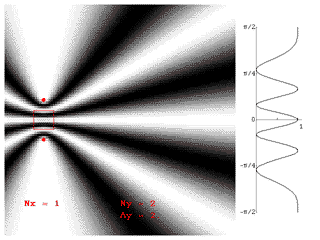![]()
![]()
Illustrated are the near and far field normalized intensities of one and two dimensional arrays of point scatterers. The incident plane wave illumination is from the left, non-scattered radiation is not included, and polarization is not factored into the calculations.
 In
this movie,
which is intended to be viewed one frame at a time (as in a slide show),
images of the in-plane near-field intensities are displayed. The scatterers
are indicated by red dots and a reference square one wavelength on a side
is also displayed. Along the right side is a line plot of the far-field
intensity covering either ±90° or ±180° from the
forward scattering direction, as required.
In
this movie,
which is intended to be viewed one frame at a time (as in a slide show),
images of the in-plane near-field intensities are displayed. The scatterers
are indicated by red dots and a reference square one wavelength on a side
is also displayed. Along the right side is a line plot of the far-field
intensity covering either ±90° or ±180° from the
forward scattering direction, as required.
Nx, Ny are the number of columns and rows, respectively, of scatterers. Delta-x, delta-y are the inter-scatterer spacing of the respective columns and rows in units of one wavelength.
The movie has ten different scatterer configurations, each with spacing stepped from 1/8 a wavelength to 2 wavelengths. They comprise, in order, 1x2, 1x3, 1x7, 2x1, 3x1, 7x1, 2x2, 3x3, 7x7, and a 7x7 randomized arrays of scatterers. The scale of the image is adjusted to show the majority of the interesting near-field region.
An interesting alternate interpretation of these images is as radiators for high-gain antenna arrays. If each point radiator has its feed phased to match that which would occur in our scattering model then the pattern of radiation is just the same as if they were scattering from an incident plane wave. Note that when there is scattering (radiating) in anything less than an omnidirectional pattern then the array, as an antenna, is said to have "gain" in the direction(s) of radiation remaining. The 7x7 random array, in particular, has a very high forward gain over a wide range of wavelengths.
To view the movie requires your computer to have QuickTime installed (available free from Apple Computer at their QuickTime Software page). The movie is playable on Macintosh, Windows, and some Unix platforms. See Apple's QuickTime Home page for currently supported operating systems and general information about this widely adopted time-based media standard.
![]()
Use and distribution of this material is free but limited to non-profit educational use only, and the author reserves all rights of ownership. E-mail: McHargue@Physics.Montana.Edu
©1996 William B. McHargue